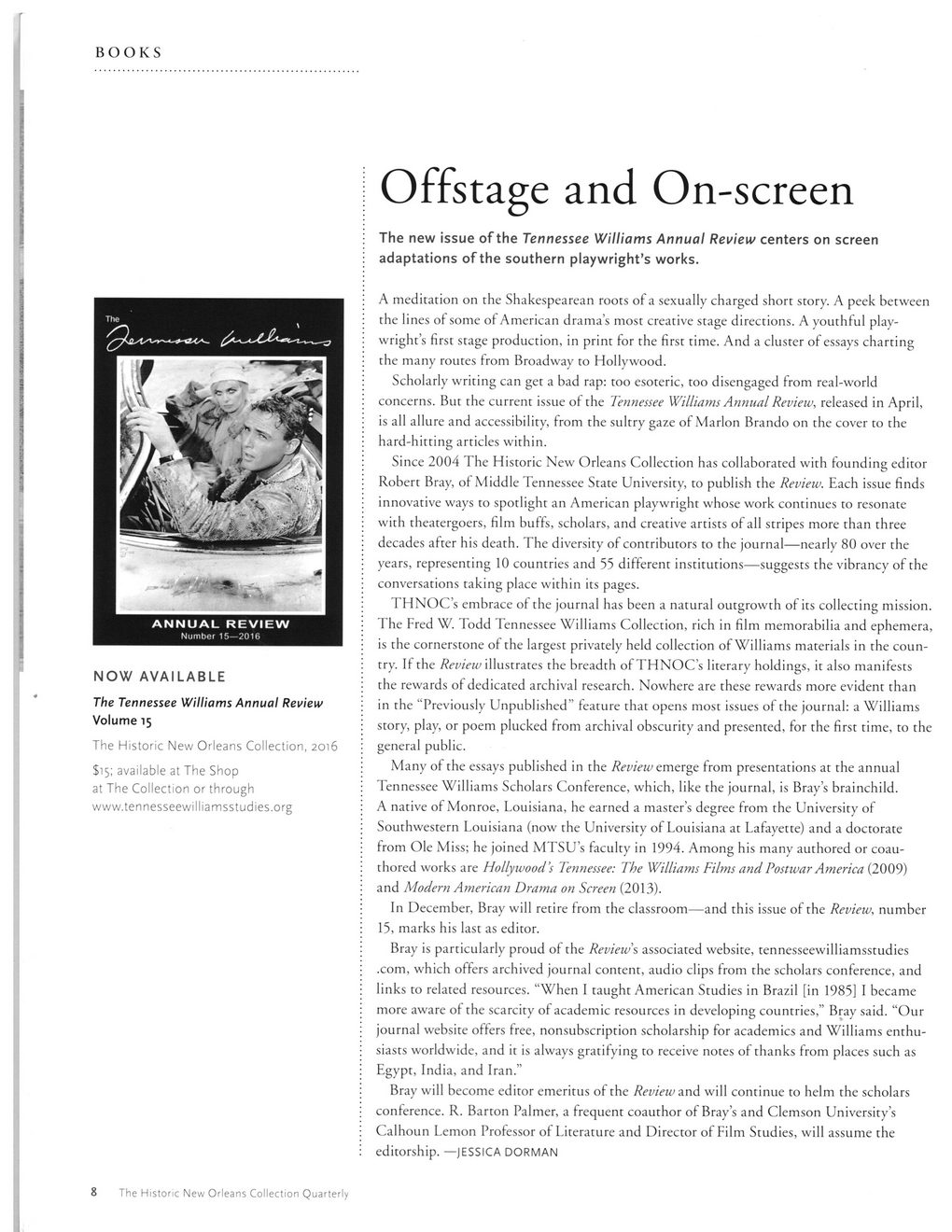This text was obtained via automated optical character recognition.
It has not been edited and may therefore contain several errors.
BOOKS The ANNUAL REVIEW Number 15—2016 NOW AVAILABLE The Tennessee Williams Annual Review Volume 15 The Historic New Orleans Collection, 2016 $15; available at The Shop at The Collection or through www.tennesseewilliamsstudies.org Offstage and On-screen The new issue of the Tennessee Williams Annual Review centers on screen adaptations of the southern playwright’s works. A meditation on the Shakespearean roots of a sexually charged short story. A peek between the lines of some of American drama’s most creative stage directions. A youthful playwright’s first stage production, in print for the first time. And a cluster of essays charting the many routes from Broadway to Hollywood. Scholarly writing can get a bad rap: too esoteric, too disengaged from real-world concerns. But the current issue of the Tennessee Williams Annual Review, released in April, is all allure and accessibility, from the sultry gaze of Marlon Brando on the cover to the hard-hitting articles within. Since 2004 The Historic New Orleans Collection has collaborated with founding editor Robert Bray, of Middle Tennessee State University, to publish the Review. Each issue finds innovative ways to spotlight an American playwright whose work continues to resonate with theatergoers, film buffs, scholars, and creative artists of all stripes more than three decades after his death. The diversity of contributors to the journal—nearly 80 over the years, representing 10 countries and 55 different institutions—suggests the vibrancy of the conversations taking place within its pages. I HNOC’s embrace of the journal has been a natural outgrowth of its collecting mission. The Fred W. Todd Tennessee Williams Collection, rich in film memorabilia and ephemera, is the cornerstone of the largest privately held collection of Williams materials in the country. If the Review illustrates the breadth of THNOC’s literary holdings, it also manifests the rewards of dedicated archival research. Nowhere are these rewards more evident than in the “Previously Unpublished” feature that opens most issues of the journal: a Williams story, play, or poem plucked from archival obscurity and presented, for the first time, to the general public. Many of the essays published in the Review emerge from presentations at the annual Tennessee Williams Scholars Conference, which, like the journal, is Bray’s brainchild. A native of Monroe, Louisiana, he earned a master’s degree from the University of Southwestern Louisiana (now the University of Louisiana at Lafayette) and a doctorate from Ole Miss; he joined MTSU’s faculty in 1994. Among his many authored or coauthored works are Hollywood’s Tennessee: The Williams Films and Postwar America (2009) and Modern American Drama on Screen (2013). In December, Bray will retire from the classroom—and this issue of the Review, number 15, marks his last as editor. Bray is particularly proud of the Review’s associated website, tennesseewilliamsstudies .com, which offers archived journal content, audio clips from the scholars conference, and links to related resources. “When I taught American Studies in Brazil [in 1985] I became more aware of the scarcity of academic resources in developing countries,” Bray said. “Our journal website offers free, nonsubscription scholarship for academics and Williams enthusiasts worldwide, and it is always gratifying to receive notes of thanks from places such as Egypt, India, and Iran.” Bray will become editor emeritus of the Review and will continue to helm the scholars conference. R. Barton Palmer, a frequent coauthor of Bray’s and Clemson University’s Calhoun Lemon Professor of Literature and Director of Film Studies, will assume the editorship. —JESSICA DORMAN 8 The Historic New Orleans Collection Quarterly

New Orleans Quarterly 2016 Summer (009)